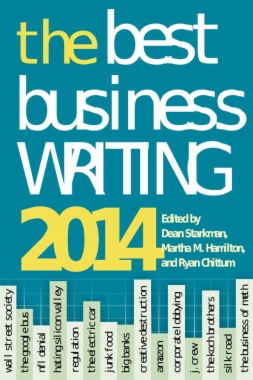This anthology of the year's best investigative business writing explores the secret dealings of an elite Wall Street society and uncovers the crimes and misadventures of the young founder of Silk Road, the wildly successful online illegal goods site known as the "eBay of vice." It reveals how the Fed dithered while the financial crisis unfolded and explains why the leaders of a two-trillion-dollar bond fund went to war with each other. Articles from the best newspapers and magazines in the country delve into how junk-food companies use science to get you to eat more and how Amazon dodges the tax man how J.Crew revitalized itself by transforming its creative process and Russell Brand went deep on media and marketing after his GQ Awards speech went haywire.
Best Business Writing 2014 includes provocative essays on the NFL's cover-ups and corporate welfare, Silicon Valley's ultralibertarian culture, and the feminist critique of Sheryl Sandberg's career-advice book for women, Lean-In. Stories about toast, T-shirt making, and the slow death of the funeral business show the best writers can find worthy tales in even the most mundane subjects.
- Table of Contents
- Introduction, by Dean Starkman
- Acknowledgments
- Part I. Silicon Culture
- 1. Why We Are Allowed to Hate Silicon Valley, by Evgeny Morozov
- 2. Diary: Google Invades, by Rebecca Solnit
- 3. Facebook Feminism, Like It or Not, by Susan Faludi
- 4. Dead End on Silk Road: Internet Crime Kingpin Ross Ulbricht’s Big Fail, by David Kushner
- Part II. Brave New Economic World
- 5. A Tale of Two Londons, by Nicholas Shaxson
- 6. London’s Laundry Business, by Ben Judah
- 7. How Technology and Hefty Subsidies Make U.S. Cotton King, by Robert Smith
- 8. Invisible Child: Girl in the Shadows: Dasani’s Homeless Life, by Andrea Eliot
- 9. Russell Brand and the GQ Awards: “It’s Amazing How Absurd It Seems”, by Russell Brand
- 10. Maximizing Shareholder Value: The Goal That Changed Corporate America, by Jia Lynn Yang
- Part III. Frenzied Finance
- 11. One Percent Jokes and Plutocrats in Drag: What I Saw When I Crashed a Wall Street Secret Society, by Kevin Roose
- 12. Here’s Why Wall Street Has a Hard Time Being Ethical, by Chris Arnade
- 13. How the Fed Let the World Blow Up in 2008, by Matthew O’Brien
- 14. Gross vs. El-Erian: Inside the Showdown Atop the World's Biggest Bond Firm, by Gregory Zuckerman amd Kirsten Grind
- 15. Secret Currency Traders’ Club Devised Biggest Market’s Rates, by Liam Vaughan, Gavin Finch, and Bob Ivry
- 16. Lunch with the FT: Meredith Whitney, by Lucy Kellaway
- 17. A Pivotal Financial Crisis Case, Ending with a Whimper, by Jesse Eisinger
- Part IV. Unhealthy Business
- 18. Use Only as Directed, by Jeff Gerth and T. Christian Miller
- 19. Merchants of Meth: How Big Pharma Keeps the Cooks in Business, by Jonah Engle
- 20. The Extraordinary Science of Addictive Junk Food, by Michael Moss
- 21. League of Denial: The NFL’s Concussion Crisis, by Michael Kirk, Mike Wiser, Steve Fainaru, and Mark Fainaru-Wada
- Part V. Creative Destruction
- 22. How Jenna Lyons Transformed J.Crew Into a Cult Brand, by Danielle Sacks
- 23. The Mysterious Story of the Battery Startup That Promised GM a 200-Mile Electric Car, by Steve LeVine
- 24. The Death of the Funeral Business, by Sandy Hingston
- 25. Declara Co-Founder Ramona Pierson’s Comeback Odyssey, by Ashlee Vance
- 26. A Toast Story, by John Gravois
- Part VI. The Politics of Business
- 27. Washington’s Robust Market for Attacks, Half-Truths, by Michael Kranish
- 28. He Who Makes the Rules, by Haley Sweetland Edwards
- 29. A Word from Our Sponsor, by Jane Mayer
- 30. Amazon’s (Not So) Secret War on Taxes, by Peter Elkind with Doris Burke
- 31. How the NFL Fleeces Taxpayers, by Gregg Easterbrook
- List of Contributors
- Permissions

